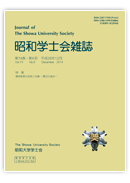Volume 74, Issue 6
Displaying 1-13 of 13 articles from this issue
- |<
- <
- 1
- >
- >|
Feature Articles: Recent Advances in the Diagnosis and Treatment of Psychiatric Disorders
-
2014 Volume 74 Issue 6 Pages 607-608
Published: 2014
Released on J-STAGE: August 04, 2015
Download PDF (198K) -
2014 Volume 74 Issue 6 Pages 609-613
Published: 2014
Released on J-STAGE: August 04, 2015
Download PDF (503K) -
2014 Volume 74 Issue 6 Pages 614-620
Published: 2014
Released on J-STAGE: August 04, 2015
Download PDF (1232K) -
2014 Volume 74 Issue 6 Pages 621-627
Published: 2014
Released on J-STAGE: August 04, 2015
Download PDF (494K) -
2014 Volume 74 Issue 6 Pages 628-634
Published: 2014
Released on J-STAGE: August 04, 2015
Download PDF (341K) -
2014 Volume 74 Issue 6 Pages 635-640
Published: 2014
Released on J-STAGE: August 04, 2015
Download PDF (334K) -
2014 Volume 74 Issue 6 Pages 641-653
Published: 2014
Released on J-STAGE: August 04, 2015
Download PDF (757K)
Review
-
2014 Volume 74 Issue 6 Pages 654-660
Published: 2014
Released on J-STAGE: August 04, 2015
Download PDF (321K)
Original
-
2014 Volume 74 Issue 6 Pages 661-668
Published: 2014
Released on J-STAGE: August 04, 2015
Download PDF (1770K) -
2014 Volume 74 Issue 6 Pages 669-674
Published: 2014
Released on J-STAGE: August 04, 2015
Download PDF (457K)
Case Report
-
2014 Volume 74 Issue 6 Pages 675-681
Published: 2014
Released on J-STAGE: August 04, 2015
Download PDF (955K) -
2014 Volume 74 Issue 6 Pages 682-690
Published: 2014
Released on J-STAGE: August 04, 2015
Download PDF (906K)
Proceedings of the 61st General Meeting of the Showa University Society
-
2014 Volume 74 Issue 6 Pages 691-741
Published: 2014
Released on J-STAGE: August 04, 2015
Download PDF (1212K)
- |<
- <
- 1
- >
- >|
